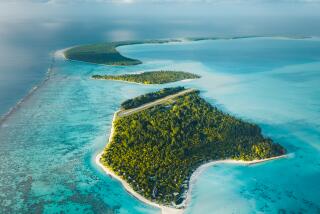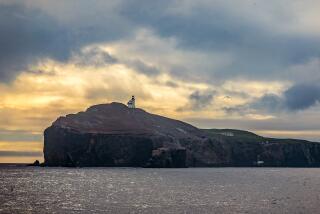Taking the Plunge : At Guadeloupe, the ‘Island With Everything,’ the Idea Was to Stay in the Water
- Share via
GUADELOUPE, West Indies — A huge cement cross loomed above us, a monument to shipwrecks offshore; equally huge rocks loomed below. We loomed somewhere in the middle, clawing our way toward the top of Guadeloupe’s easternmost cliff--and straight into a bloodthirsty thornbush.
That’s when the same thought hit us both:
This was our Caribbean beach vacation?
Oops. I was on the first Caribbean island of my life, and I’d already learned and forgotten the great lesson of the Antilles within 24 hours of arriving.
It was this: Stay in the water. Nothing bad can happen to you there. In the water, impossibly warm and clear, everything’s wonderful and nothing matters. Float. Dive. Mmmmmmm.
The proof had come immediately the day before. From the terrace of our miniature cottage, we’d looked down on our hotel’s tiny cove, where we intended to make our first Caribbean plunge together.
It looked like a deserted mud flat. But after six hours in airplanes and airports, we had pledged to swim at the earliest opportunity. Now dusk was hitting the surf before we were. Down a dark path we hurried, gripping hotel towels and upholding an unspoken pact of I’ll-keep-smiling-if-you-will.
We pitched ourselves into the water, and everything changed. We surfaced in a new landscape, or at least in a new perspective. What lovely brown sand (not mud after all), what a glorious view, what a cute little cove.
And now we couldn’t stop smiling. Everything was wonderful; nothing mattered. We floated. We dived. Mmmmmmm.
I know, I know. I wouldn’t believe it, either. That Caribbean Sea, sure, it’s nice and warm and it turns a dozen pretty shades of blue and green and it’s so buoyant that it gathers around you and lifts you like an invisible cushiony raft, yeah, yeah, but it doesn’t have miracle healing powers, correct?
All I know is, we stayed in that modest little cove past nightfall, until the hotel turned its spotlight on the water and got a bright eyeful of my girlfriend and me swirling around together like those giddy tourist couples in TV commercials. When we climbed back up the bluff, our wicker-furnished room, which had looked just maybe a tad shabby at first, now looked like one of the all-time travel finds, our own private treehouse over the sea.
Was it because of the water that even the farmland scenery of Guadeloupe’s interior would seem so bewitching? That sugar, chocolate, coffee, avocados, grapefruits and bananas would taste like nothing else in this world? That for once in our lives we would tan and tan but never burn?
It was suddenly clear why Caribbean travelers often just select an island, step onto the nearest beach, and then barely budge until the plane leaves, attempting no tasks more demanding than deciding on a level of sunscreen or the color of a cocktail.
And yet, this great lesson didn’t quite take.
*
After all, we’d chosen Guadeloupe because it was the island with everything. “The Caribbean in miniature,” was one guidebook’s enthusiastic phrase, picked up during our long sojourns in bookstore travel sections. We were bound and determined to do it all.
This was the island with both a volcano and a casino; with sands of nearly every color and a rain forest with a permanent rainbow; with some of the best snorkeling, some of the best French and Creole food, some of the best roads. It was the island so diverse it was actually two islands, one of flat coral and the other volcanic and mountainous, separated by the only channel in the world connecting the Caribbean Sea and the Atlantic Ocean.
By the end of the week, we would circumnavigate both the mountainous Basse-Terre and flat Grande-Terre and visit a tiny offshore island to boot--despite numerous wrong turns, several missed or misread road signs (they’re in French), and temptations to spend hours each day eating dishes that were a total mystery.
Wherever we went, we looked for the water, to wash all that traveling away. It wasn’t just the 11 beaches we sampled; we also bathed under two waterfalls, swam laps in a farm-country hot springs, snorkeled among hundreds of fish at Jacques Cousteau’s favorite reef, and even got wet in the rain--in the rain forest, of course. On our first day, we drove five minutes to Guadeloupe’s largest white-sand beach, Plage Caravelle, which gave shape to our cottage’s ocean view. Caravelle was bustling--mostly with vendors walking up and down the shoreline with plates of pastries, calling “Cho-cho-chocolat,” the French Caribbean equivalent of “Peanuts hear.” But the water was serene. This is Club Med’s location, and the perfect line of palms is certainly the resort’s doing, but in Guadeloupe all beaches are public up to the high-tide mark. We pulled up a palm and sat down for the morning.
*
It was in the afternoon that we headed to the eastern tip of the island, Pointe des Chateaux, and lost our heads for a minute climbing up to the giant cross.
We did finally reach the top, a little scratched and a little shaky. We were rewarded with a view back over the entire upper island of Grande-Terre--and the realization that we had totally missed the nice little path built for tourists. But a quick dip in the breakers below eased the pain and suffering.
The next day, a beach all the way to the west did the same thing. We had to take care of business in the morning--changing money in the busy, traffic-plagued center city, Pointe-a-Pitre, and changing our rental car because the first one had proved a little unreliable in the steering, brakes and ignition departments. Armed with new wheels, we sped onto the mountainous lower island of Basse-Terre--and drove right through the national park that was our destination, without realizing it. (Those darn little French signs again.)
Our consolation was the beach on the other side: La Grande Anse, a wild, empty stretch the color of raw sugar, with water that we stayed in for an hour at a time. Adding to the beach’s mystique was a palm-shaded restaurant, Karacoli, with fiery stuffed crab and its own hidden entrance onto the sand.
Day Three was our grand tour of Grande-Terre, bracketing the island’s northern point, named literally “The Great View,” with visits to three different beaches on the route. At one, Anse Laborde, the beach hosted a cow; at the next, Anse de Souffleur, the beach had a cemetery. We reached that one at sunset, and walked through the memorials of black and white tile and fresh bouquets lit by a purple sky.
We returned the next day to the park, by way of Basse-Terre’s gorgeous rolling farmland and a hot springs turned into a spa. Once in the park, a short hike brought us to a waterfall where locals and tourists swam together, with the veterans showing the neophytes how to sit directly under the falls and dive through to the other side.
It was the coldest water we had been in, and we didn’t care. We dried off, sat down with a picnic of baguettes and Camembert, and then jumped into the waterfall again.
*
After a day on the offshore island Terre-de-Haut, with fine coves of its own, we had our last marine adventures.
First we took a glass-bottomed boat to Pigeon Island, whose coral reef preserve, often featured by Jacques Cousteau, is now named after him. The place is a haven for divers, but mere snorkelers can swim amid entire schools of curious rainbow-colored fish just as easily--even first-timers like me. It was, I imagine, like visiting outer space, only better because of the refreshing ocean.
There was still the promise of one more waterfall, and the accomplishment of rounding the southern end of Basse-Terre--the one coastline we hadn’t traveled. The mountain roads revealed wonderful views and a choice of more beaches to sample, but the road up to the falls called “Chutes du Carbet” proved to be another trip into new territory.
A half-hour hike, well marked, brought us to the middle falls of a set of three. This one was 200 feet high and boiling; nearby, we slipped into one of its steaming pools.
We did skip a few things. We missed the Rum Museum. We passed over merchants hawking “Your Name on a Grain of Rice.” We spent only an hour in the casino and never explored the volcano.
It would have been a very long drive and a very long hike. And there would have been nowhere to swim.
GUIDEBOOK
Going to Guadeloupe
Getting there: American Airlines flies round-trip from LAX to Guadeloupe, with a change of planes in San Juan, Puerto Rico. Lowest available fare is $767. The island is part of France: You need a passport.
Where to stay: The clear winner was our own selection, La Toubana in Ste-Anne (from the U.S., tel. 011-590-88-25-78). Our cottage--bedroom, bathroom and kitchenette--was not fancy but was completely private, with a large terrace looking out to sea. The grounds were beautiful, the staff cheery and helpful, the restaurant excellent and our cove--where we never saw another soul--one of our favorite parts of the trip. High-season price: $175 double, including breakfast.
Other hotels:
Hamak in St-Francois (tel. 011-590-88-59-99), named for the hammocks on each patio, is the priciest resort. The grounds are very pleasant and so are the hammocks, but the rooms are neither particularly private nor elegant for the money. Price: about $300 for a double, including breakfast.
Hotel Arawak (tel. 011-590-84- 24-24), on the Gosier strip, seemed to have the best beach in that area and was tastefully designed for a high-rise. A more affordable alternative at about $215 for a double, including breakfast.
Le Relais du Moulin (tel. 011- 590-88-13-78) near St-Francois was probably the best bargain we saw. It’s not on the water, but the hotel beaches aren’t the best ones anyway. This one has individual cabins with views and a fine restaurant. Price: about $100 for a double, incuding breakfast.
Where to eat: It’s difficult to eat lunch for under $20 or dinner for under $30 per person unless you picnic. Here are some non-hotel restaurants worth the money:
Le Rocher du Malendure, overlooking Pigeon Island, won for best setting and best cold fish.
Restaurant Karacoli, Grand Anse beach, has terrific Creole food.
Le Relais Caraibe, Gosier, serves Creole food and lots of charm.
L’Affamilar, Gosier, was a bargain serving pizzas and grills.
More to Read
Sign up for The Wild
We’ll help you find the best places to hike, bike and run, as well as the perfect silent spots for meditation and yoga.
You may occasionally receive promotional content from the Los Angeles Times.






